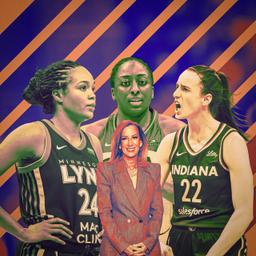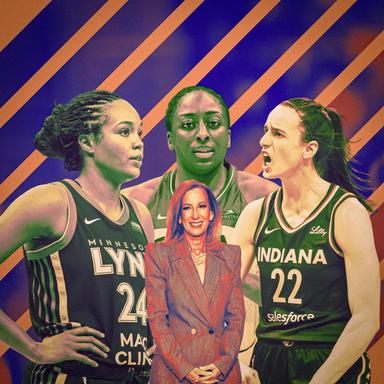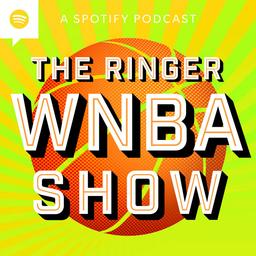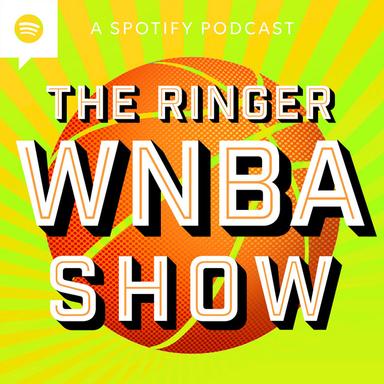If WNBA training camp is full of wide eyes and big dreams, then the days leading up to Thursday’s trade deadline are its inverse: a time to put the first half of the season under the sterile, harsh light of the operating room and decide what to fix, reinforce, or, worst case, lose entirely.
If only the WNBA general managers could see the future or had X-ray vision. Instead, they have unpredictable players, imperfect solutions, and assessments inevitably biased by their own hopes, fears, and pasts—both the failures and high-water marks. There are so many emotional decisions to ponder, so many market inefficiencies to be mined, and so, so, so many bad trades.
Midseason trades in the WNBA are difficult to make because of a hard cap that restricts movement. The league is still somewhat new to the deadline game and is in the midst of the messy, captivating beginning of so many evolutions: a first-stage capitalism gem in a late-stage capitalism world. It’s why the Minnesota Lynx can regenerate title teams by way of savvy personnel scouting, overseas and within the league, and why an expansion team like the Golden State Valkyries can be on pace for the playoffs in its inaugural season.
During free agency this past offseason, two-thirds of the league made win-now moves, and hope-fueled chaos could be on the horizon again. Four teams have already made in-season deals. With seven teams in the title race right now and three more jostling for another playoff spot, the market could be full of buyers, especially as the Lynx await an update on likely MVP Napheesa Collier, who suffered an ankle sprain against the Las Vegas Aces this weekend.
The real winner might be the team that has the stomach to sit out the championship hunt and load up for the future. With that in mind, we’re breaking the characters of this year’s trade deadline into three categories: the hustlers (screen their calls; you’re about to get fleeced), the marks (teams that think they’re one move away but aren’t), and the wild cards (players and teams that could tilt the balance but aren’t easy to read). Let’s dive in.
The Hustlers
Dallas Wings
Since taking over the Wings front office this offseason and drafting Paige Bueckers, Curt Miller, whose 8-21 team has a projected 0.4 percent chance of making the postseason and a 40 percent chance of snagging the no. 1 pick, has had two jobs:
- Finding more players (like Haley Jones and Li Yueru) to fit around Bueckers.
- Snagging draft assets from teams making last-gasp efforts to contend.
He already somehow snagged a first-round pick in the generationally stacked 2027 draft from the Las Vegas Aces back in June in exchange for NaLyssa Smith. And this past weekend, he dealt DiJonai Carrington to the Minnesota Lynx for Diamond Miller, Karlie Samuelson, and a 2027 second-round pick.
Miller, the no. 2 pick in the 2023 draft, is a fiery wing with burgeoning self-creation ability and heaps of untapped speed and athleticism—the exact kind of young player you’d want to pair with Bueckers.
With the deadline approaching, the Wings still have a few more vets they could potentially move, like forward Myisha Hines-Allen. But the big question is whether they’ll trade Arike Ogunbowale, probably the best player available on the trade market.
Since drafting Bueckers, the Wings have moved on from three critical players: Smith, Carrington, and Teaira McCowan. Now the future of a fourth is up in the air. They’ve created minutes for rookies JJ Quinerly, Aziaha James, and Luisa Geiselsoder while acquiring Yueru, Jones, Miller, and more draft capital. Not bad work for just nine months on the job.
Minnesota Lynx
Every once in a while, a hustler meets a hustler.
Before the Lynx faced the Liberty last week, a reporter asked Cheryl Reeve whether the fact that 99 percent of players are impending free agents—who are anticipating more lucrative contracts under a new collective bargaining agreement this offseason—would affect player movement at the August deadline.
“It makes it more challenging for teams that maybe have a player and maybe in an ordinary year could be a seller because of what their future goals are,” said Reeve. “The value isn’t going to be there, as it would be in normal years. … It could produce nothing as a result because maybe the price tag is too high, or if the price tag comes down, then maybe you’ll see some movement.”
I can’t help but wonder now whether she was thinking about her own team’s negotiations with the Wings, who likely would have loved to get a first-round pick back for Carrington.
Carrington has been tactically YOLO-ing on the losing Wings roster, playing defense from behind and gambling in nearly every passing lane—accentuating the “free” in the “free safety” role she thrived in with the Connecticut Sun. She’s also been quick to the draw on her shaky jumper and posting a career high in usage, which will almost certainly decline once she arrives in Minnesota. She’s a year removed from being the league’s best perimeter defender, and there’s reason to believe that a change of scenery could unleash the fire that fueled her 2024 Most Improved Player campaign. She’ll likely vibe a lot better with the decorated Reeve, who is acerbic but empathetic, than she did with Wings rookie coach Chris Koclanes, who has looked overwhelmed at times. After all, the Lynx built their championship-level roster by collecting lost, underused misfits from other teams.
The 24-5 Lynx, who have both the top offense and top defense, have steamrolled over the rest of the league so far this season. But they’ve also struggled against physical frontcourts like Indiana’s and Atlanta’s, and an ankle injury suffered by Collier further limits their frontcourt depth—and throws an existential wrench into their season. I have to imagine that the Lynx will keep looking for rebounding help—whether it’s in the trade, overseas, or buyout market.
And I’ll always wonder what an actualized version of Miller, who was part of the trade for Carrington, could have looked like on this Lynx roster, but a little bit of ambivalence and disappointment on both sides is often the hallmark of a fair trade.
Washington Mystics
In February, Jamila Wideman opened her tenure as Mystics general manager with a bang by trading for the no. 3 pick and swiping rookie star Sonia Citron. Now she has a chance to make another splash ahead of the deadline; she has a roster full of movable vets like Emily Engstler and Stef Dolson who would be attractive to contenders, and she has a crown jewel in first-time All-Star Brittney Sykes. They’re also reportedly taking calls about Aaliyah Edwards, the no. 6 pick in the 2024 draft, who has taken a back seat to rookie standout Kiki Iriafen.
The Mystics, who are still on the playoff bubble, could hypothetically stand pat. They already have plenty of solid incoming draft capital: Minnesota’s first- and second-rounders in 2026 and a first-round pick swap with Chicago in 2027. If they continue to be competitive, they’ll likely play themselves out of drafting in the lottery with their own picks, so it wouldn’t hurt to keep stacking up future assets. The Mystics rebuild is ahead of schedule, but they might need to slow it down to maximize their potential.
The Marks
Seattle Storm
Seattle is in a fascinating position. Not only is it a playoff contender, but it also has incredible bargaining chips at its disposal: the Sparks’ 2026 first-round pick—likely a top-three selection—as well as Vegas’s first-round pick, Dallas’s second-rounder, and all its own picks.
At 16-13, the Storm are straddling two timelines. A year ago, they conglomerated their Big Three of Nneka Ogwumike, Skylar Diggins, and Jewell Loyd (who is now on the Aces) in hopes of winning a title. This year, they also drafted Dominique Malonga, a 6-foot-6, 19-year-old court-warping French phenom, who will shepherd them into their next era.
The question heading into the deadline is who Seattle really thinks it is. Is it a veteran squad ready to make a push, or is it just waiting for the next era? It’s just two games back of the no. 3 seed, but it’s also suffered losses to bottom dwellers like Dallas and Connecticut. Diggins is in the midst of a bounce-back year, while Gabby Williams and Erica Wheeler, who were scorching hot from beyond the arc to begin the year, have come down to earth.
The problem is that shooting isn’t their only need. The Storm are the second-worst defensive rebounding team in the league, and their lack of wings hinders their lineup versatility. If I were Seattle, I wouldn’t be having conversations about trading away the Sparks pick unless I could get a promising, cost-controlled rookie or sophomore back that addresses those problems.
There is one deal that scratches all those itches, and it involves Marina Mabrey, who has been connected to Seattle in trade talks all season. What if the Sun threw in Olivia Nelson-Ododa, a restricted free agent who may not return, and rookie standout Saniya Rivers in exchange for the Sparks pick, the Vegas pick, and Alysha Clark, Lexie Brown, and Mackenzie Holmes?
With the Sparks pick, Connecticut would have a chance to draft a star (more on that below). Meanwhile, the Storm would be able to form a terrifying young defensive core around Rivers, Malonga, and Ezi Magbegor. Mabrey would alleviate their shooting woes and provide another steady hand. And if that trade doesn’t work, maybe the Storm could snag Ogunbowale and Hines-Allen from the Wings. Or how about Ariel Atkins and Rebecca Allen from the Sky?
(For what it’s worth, I’d hold on to the Sparks pick for a shot at drafting Azzi Fudd or Olivia Miles, two elite guards who could bolster a 2026 title run and serve as foundational pieces for the future.)
Las Vegas Aces
The Aces have gone from winning back-to-back titles and modernizing the league to becoming a walking doormat, watching opponents post records on them. It’s a steep, discombobulating fall that may be obvious to outsiders, but it’s harder to recognize when you’re in it.
Complicating matters is the fact that Becky Hammon, the coach who helmed the Aces at their peak, has also been largely in charge of the personnel moves that got them here (Hammon essentially took over for GM Natalie Williams this offseason). There’s also the pressure not to waste another prime season from A’ja Wilson, whose per-36 production is on par with last year’s generational MVP campaign.
All of which is probably why the struggling 15-14 Aces have made a spate of future-mortgaging decisions, including the trade for Smith.
Predictably, swapping in Smith for Kiah Stokes (who is averaging 1.5 points on 36 percent shooting this season) has infused the starting lineup with life, to the tune of an extra 10 points per 100 possessions. But that starting group is still not on the level of the Liberty or the Lynx—or even the Storm, Dream, or Mercury.
The Aces’ goal is clearly to contend for a title, but Hammon also has to make calculations about pulling the starters out early against Minnesota to keep them fresh for a back-to-back against the Valkyries, because two losses in a row would dent their playoff hopes.
They need more athleticism, rebounding, defensive versatility, and rim pressure. A deal with the Mystics involving Brittney Sykes and Stef Dolson could potentially take care of those problems, but the Aces’ leftover trade chips—rookie sharpshooter Aaliyah Nye and some second-round picks—aren’t going to move the needle. They could potentially call the league office about trading their 2028 first-rounder, but that conversation might be tense, considering the way the Aces are laughing in the face of certain snail-paced league investigations.
The psychic memory of two titles doesn’t go away in the face of a mediocre net rating or a .500 start. I wonder: Will this weekend’s record-setting 53-point blowout loss at home do the trick?
Phoenix Mercury
The Mercury have a smart front office. Their designation here is more of a commentary on how much they have leveraged in the present moment, after putting together a Big Three of Alyssa Thomas, Kahleah Copper, and Satou Sabally this offseason. They’re deep, thanks to some savvy overseas scouting, and they play a brand of positionless basketball that tends to travel well in the postseason. Their toughest opponents, the Liberty and the Lynx, are dealing with injury issues, and when they’re healthy, the Mercury really have only one deficiency: rebounding. Beyond some second-round picks, they don’t have a lot of assets left to trade. What they do have, though, is a 2027 first-round pick and a dream that may genuinely be within reach.
The Wild Cards
Chicago Sky
Toeing the line between mark and wild card are the Sky, who traded the no. 3 pick (Sonia Citron, a player who happens to fit their current and future needs) for Ariel Atkins. They also relinquished pick swap rights in 2027 to the Mystics, to bolster a roster around Angel Reese and Kamilla Cardoso in hopes of making the postseason.
It didn’t work.
The Sky have stumbled out to a 7-21 start. The season has been a discombobulated, injury-ridden disaster, and they currently have a 0.1 percent chance of making the playoffs.
To make matters worse, the Sky owe their first-rounder—likely a top-three pick—to Minnesota thanks to the Reese deal (Reese is a foundational piece, so at least you can live with that). It helps that Chicago owns Phoenix’s first-rounder, which it can swap for Connecticut’s pick thanks to the Marina Mabrey trade, but this is a team that desperately needs to get younger, and the best way to swallow its offseason mistakes, and reverse course, is by making Atkins available in trade talks. A team like Seattle would love her combination of floor spacing, defense, and championship experience. The only thing stopping the Sky, beyond an under-the-table nudge suggesting that Atkins will re-sign long term after her contract expires at the end of this season, is pride.
Connecticut Sun
The Sun may or may not be sold to a Boston-based ownership group very soon, and it’s unclear how that will impact their deadline decision-making. Either way, the people in charge of the present are unlikely to be in charge of the future, which can always make things interesting.
After losing their entire starting lineup this offseason, the Sun are in the midst of a complete teardown. But years of contention—plus a WNBA rule that calculates lottery odds based on the past two seasons—have left their asset chest dry. Despite having the worst record in the league, they won’t have a lottery pick this year and instead will be selecting at the bottom of the first round—thanks to a pick swap owned by Chicago (via Phoenix).
They’ve got a host of promising young players in Leila Lacan, Nelson-Ododa, Saniya Rivers, Aneesah Morrow, and Jacy Sheldon. But they could use as many bites at the apple as possible to get star-level talent into the building, especially since Connecticut isn’t exactly a free agency destination—though that could change soon.
Marina Mabrey, whose trade request was rejected this offseason, remains an interesting trade candidate. A motor-mouthed flamethrower who can get hot at any moment, Mabrey has an I-took-that-personally energy that I would personally like to see in the postseason. And Nelson-Ododa, 24, boasts a combination of size, rim protection, switchability, IQ, and motor off the bench that multiple contenders in need of rebounding would likely salivate over.
If the Sun feel confident in Nelson-Ododa re-signing, perhaps a deal that includes Mabrey and Tina Charles, the best rebounder of all time, could yield a valuable pick. If Seattle decides to push forward, Mabrey and Charles would solve its shooting and rebounding issues. Would Seattle relinquish a first-round pick and the necessary salaries to make it work? There’s a reason the Storm are a mark.
Arike Ogunbowale and Jewell Loyd
A few weeks ago, the decision to trade Arike Ogunbowale would have been easy.
She boasts one of the deepest bags in the game, but her iso-heavy style clashed with Paige Bueckers’s pass-happy, fast-paced game. Twenty games into the season, the veteran was posting career lows in points and efficiency, while the Wings actually hummed better with rookies Aziaha James and JJ Quinerly on the floor.
But over the past few weeks, something has shifted. She looks like Arike, the four-time All-Star again, but different: more focused, decisive, unselfish. She dished out a career-high 14 assists in a win against the Liberty last week. She’s moving the ball and running the floor, making quick reads off dribble handoffs with new addition Haley Jones, who has assisted Ogunbowale nine times, more than any other Wing. Is it possible that Jones is the connector that can make Arike and Paige cohere?
Beyond that, Ogunbowale also looks happy. She looks engaged. She looks, maybe, like someone who would want to be in Dallas long term and help the front office build a team around Bueckers. It’s worth remembering how thrilled she was when the Wings got the no. 1 pick in the draft. Hell, she even made up with Geno.
The Wings have plenty of draft capital as is, and there’s no guarantee they would draft someone as talented as Ogunbowale if they were to give her up.
But at the same time, she is one of the few genuine game-changers potentially available at this deadline. Would Seattle (minus-4.3 in the clutch this season) relinquish its two non-Sparks first-rounders for her?
What about a direct swap for Jewell Loyd—a quicker, though older, potential running mate for Bueckers—and a few second-rounders? Their salaries are the exact same, down to the dollar.
Ogunbowale would certainly be a more natural fit with the Aces offense, which relies heavily on guard creation and pick-and-rolls with Wilson. It would also be fascinating to see how dangerous Ogunbowale could be as the de facto no. 2 scoring option, surrounded by threats.
Loyd is going through an awkward season in her own right after she was relegated to a role as a spot-up shooter since being traded to the Aces during the offseason. Since asking to come off the bench, though, the Gold Mamba has looked a lot more like her zippy, tough-shot-making self. And despite the difficult on-court season, she seems happy in Las Vegas—an important factor considering how messy her Storm exit was. Even after the Aces got blown out by the Lynx, she applauded the locker room’s camaraderie.
“This locker room is so close,” she said. “The confidence level for each player, day in and day out, is there. That’s the beautiful part. There’s no drama. You can have a season like this and it can be a terrible one, terrible teammates. That’s not the case here.”
On paper, both Loyd and Ogunbowale could use a change of scenery. In both cases, it’s hard to know whether there’s more to be gained in cutting bait or in sticking around.




